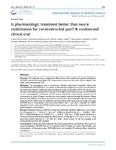Mostrar el registro sencillo del ítem
Is pharmacologic treatment better than neural mobilization for cervicobrachial pain? A randomized clinical trial
| dc.contributor.author | López-López, Daniel | |
| dc.contributor.author | Calvo-Lobo, César | |
| dc.contributor.author | Unda Solano, Francisco | |
| dc.contributor.author | Sanz Corbalán, Irene | |
| dc.contributor.author | Romero Morales, Carlos | |
| dc.contributor.author | Palomo-López, Patricia | |
| dc.contributor.author | Seco Calvo, Jesús | |
| dc.contributor.author | Rodríguez Sanz, David | |
| dc.date.accessioned | 2022-03-15T11:44:58Z | |
| dc.date.available | 2022-03-15T11:44:58Z | |
| dc.date.issued | 2018 | |
| dc.identifier.citation | Calvo-Lobo C, Unda-Solano F, López-López D, et al. Is pharmacologic treatment better than neural mobilization for cervicobrachial pain? A randomized clinical trial. Int J Med Sci. 2018;15(5):456-465. Published 2018 Mar 8. doi:10.7150/ijms.23525 | es_ES |
| dc.identifier.uri | http://hdl.handle.net/2183/29998 | |
| dc.description.abstract | [Abstract] Purpose: This study aim was to compare the effectiveness of the median nerve neural mobilization (MNNM) and cervical lateral glide (CLG) intervention versus oral ibuprofen (OI) in subjects who suffer cervicobrachial pain (CP). Methods: This investigation was a, multicenter, blinded, randomized controlled clinical trial (NCT02595294; NCT02593721). A number of 105 individuals diagnosed with CP were enrolled in the study and treated in 2 different medical facilities from July to November 2015. Participants were recruited and randomly assigned into 3 groups of 35 subjects. Intervention groups received MNNM or CLG neurodynamic treatments, and the (active treatment) control group received an OI treatment for 6 weeks. Primary outcome was pain intensity reported through the Numeric Rating Scale for Pain (NRSP). Secondary outcomes were physical function involving the affected upper limb using the Quick DASH scale, and ipsilateral cervical rotation (ICR) using a cervical range of motion (CROM) device. Assessments were performed before and 1 hour after treatment for NRSP (baseline, 3 and 6 weeks) and CROM (baseline and 6 weeks), as well as only 1 assessment for Quick DASH (baseline and 6 weeks). Results: Repeated-measures ANOVA intergroup statistically significant differences were shown for CP intensity (F(2,72) = 22.343; P < .001; Eta2 = 0.383) and Quick DASH (F(2,72) = 15.338; P < .001; Eta2 = 0.299), although not for CROM (F(2,72) = 1.434; P = .245; Eta2 = 0.038). Indeed, Bonferroni´s correction showed statistically significant differences for CP intensity (P < .01; 95% CI = 0.22 - 3.26) and Quick DASH reduction (P < .01; 95% CI = 8.48 - 24.67) in favor of the OI treatment at all measurement moments after baseline. Conclusions: OI pharmacologic treatment may reduce pain intensity and disability with respect to neural mobilization (MNNM and CLG) in patients with CP during six weeks. Nevertheless, the non-existence of between-groups ROM differences and possible OI adverse effects should be considered. | es_ES |
| dc.language.iso | eng | es_ES |
| dc.publisher | Ivyspring | es_ES |
| dc.relation.uri | 10.7150/ijms.23525 | es_ES |
| dc.rights | Atribución-NoComercial 3.0 España | es_ES |
| dc.rights.uri | http://creativecommons.org/licenses/by-nc/3.0/es/ | * |
| dc.subject | Neck | es_ES |
| dc.subject | Cuello | es_ES |
| dc.subject | Non-steroidal anti-inflammatory agents | es_ES |
| dc.subject | Agentes antiinflamatorios no esteroideos | es_ES |
| dc.subject | Musculoskeletal manipulations | es_ES |
| dc.subject | Manipulaciones musculoesqueléticas | es_ES |
| dc.subject | Rehabilitation | es_ES |
| dc.subject | Rehabilitación | es_ES |
| dc.subject | Upper extremity | es_ES |
| dc.subject | Extremidades superiores | es_ES |
| dc.title | Is pharmacologic treatment better than neural mobilization for cervicobrachial pain? A randomized clinical trial | es_ES |
| dc.type | info:eu-repo/semantics/article | es_ES |
| dc.rights.access | info:eu-repo/semantics/openAccess | es_ES |
| UDC.journalTitle | International Journal of Medical Sciences | es_ES |
| UDC.volume | 15 | es_ES |
| UDC.issue | 5 | es_ES |
| UDC.startPage | 456 | es_ES |
| UDC.endPage | 465 | es_ES |
Ficheros en el ítem
Este ítem aparece en la(s) siguiente(s) colección(ones)
-
GI-UDISAP - Artigos [196]






